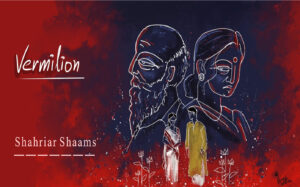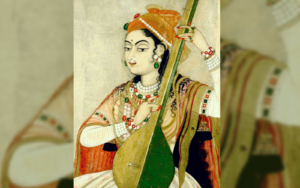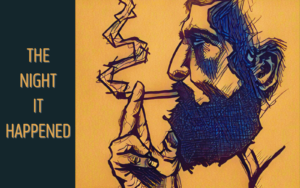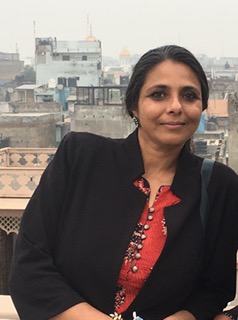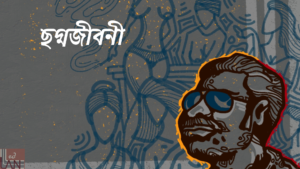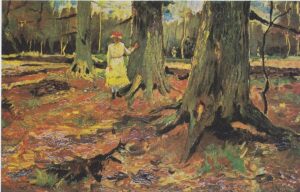Let us talk about the importance of reading more regional literature, more translations from regional languages, and of developing a bilingual (even a multi-lingual literary consciousness), which, I contend, can reduce the artificial distance between Indian languages, and hence, among people. The distance between languages is a politically created, artificial distance. The stories teeming under the cloak of different alphabets and grammars of the sub-continent, often speak of similar realities, similar gender, caste and class oppressions.
In a world, where forces much-much larger than our puny selves, have a stake in the multi-crore enterprise of building reality-shaping narratives; the one act of resistance left to the individual, is, of never relinquishing the right and the duty to connect the zig-zag line from lived experience to felt reality. And one way, is by reading diverse literature—across languages, and translating it. This is one revolution that all of us can participate in from the comfort of our bedrooms.
I will share how reading Hindi literature opened doors, for me, to intensely familiar worlds that I had, till then, felt locked out of, due to an intentionally cultivated bias for English literature, through my school and college years. The flip side was, that even when I was writing in English, I was constantly trying to translate and transpose in English, an experience that had primarily occurred in Hindi, Haryanvi, Punjabi, Bhojpuri.
Walking into the world of Hindi literature felt to me like drawing apart thick curtains to let in the morning light. As if, golden sunlight was washing over my consciousness, affirming every nuance my senses saw, heard; rejuvenating it. A feeling of validation came alive. Whether it was a lipsticked Bhagat Singh painted on the underpass walls, or the smell of winter smog or that inexplicable sense that informs us whether a person is a Bengali Malyaali or Bihari from the way they say ‘thank you’ in English; I saw every little thing leap up to reveal its story. As the tongue of the stories I read changed, a linguistic osmosis began, and new stories started bursting through the veneer of English.
****
On what authority, you may ask, can a person like me, who writes primarily in English, presume to opine on the subject of Hindi literature? The irony, the chutzpah of writing in English about Hindi!
These are wise questions to ask.
For one, I do not write in Hindi, nor am I a academic or critic. Moreover, I am a late arrival to the feast of Hindi literature. But even when writing in English, I am constantly trying to communicate the different sensibilities of people, who are talking in several local tongues, and fitting them to English meter. Just as English often needs to be decoded for those around me, who do not own it the way my education allows me to.
Hindi is my mother-tongue, and my mother’s tongue. And I have often seized the pen to render into English, some fantastic, never-read before, but utterly-familiar, deeply resonant piece of Hindi prose; so that I may share it with my non-Hindi-reading friends. As they say, truth discovered late in life comes with an extra intensity.
But before I come to Hindi literature in particular, let us talk about two problems. One is associated with India’s colonial history and the other with the resurrection of Hindi language as a nationalistic issue in current times. These respectively can be termed as the problem of the theft of language; and that of the theft of meaning.
The theft of language is a legacy of three hundred years of British rule in India. The imposition of English language ensured that Indians, both those who had mastered speaking English, and those who had not; suffered from the after-effects of “theft of language.” Those who did not speak English found their experiences and realities pushed to the margins.
Those who spoke English, were burdened by the constant necessity to translate their experience, even as they felt ashamed of it, because the centre of what was good taste was in Europe. To preserve the grit and granularity of our dialects and idioms in English was a challenge in the strange new English tongue. Over time, this struggle made its practitioners hold themselves apart from the experience itself, to cut out the rough vernacular edges of reality, to fit it into an appropriately English-speaking narrative. “Indian English” became a joke full of clunkily translated Indianisms. (None of this is to detract from the fact that English, apart from being a bridge language in South Asia, has also become, for many second and third generation speakers, a bonafide way to look at, and talk about their experiences).
Let us then, come to the theft of meaning.
Today, the most noble of words that augured a new world in mid-twentieth century—Peace, Democracy, Freedom, Truth—have been emptied of meaning. Orwell, defined literature as a sort of conversation.
“An attempt to influence the viewpoints of one’s contemporaries by recording one’s experience.”
Upendra Nath Ashk, the Proustian Hindi writer has said something similar.
“Writing emerges from a desire to share the seen, known, experienced things. From a desire to tell others what you think of all this.”
The tendency of the politics of our times is to impose a laid down viewpoint, and to erase a diversity of experiences and voices. Language itself—its imposition, strangualtion and even, its so-called “promotion”—is a mere weapon to be wielded in the electoral battlefield. When narratives are manufactured in post-truth factories, recording personal experience and lived reality are pesky hurdles, to be ignored, regulated or removed. Truth, reality, facts are problems that must be usurped by image-building, marketing, hustle or whatever may be some powerful person’s opinion at that moment.
The spoken word evaporates but literature, the written word, apart from music and art, is a way we humans connect our inner reality to the outer and become whole. Writing takes time, but once the words have been put on paper, they shape not just what we experience, but also, what, from now on, we would experience. No wonder so much effort is put in re-writing textbooks and inserting new “facts.”
Now, more than ever, literature alone can put meaning back in our words.
Arundhati Roy, in her Sebald lecture 2018 on the importance of Translation says, that “The claim of Truth cannot be made, and should not be made, by the novelist. It has to be felt by the reader.” And she, who is as acclaimed for reports and essays from the ground, as for her novels, goes on to say, why Fiction is important. “To paint a picture of Reality that cannot be told through Essays and Non-fiction alone, one has to delve in Fiction.”
But where can one find these literary truths? Truths which make the structures that rule our lives visible? That reveal the narratives we are collectively grapling with as a people? Are they even being written? Who is writing them? Not only are there fewer writers in English, who can break from the urban, middle class concerns; even the ones who talk of the rest of India cannot say that they reach the vast pool of not-English readers.
But the picture changes when we look at literature in other Indian languages. Not just Hindi, which I can read and appreciate by myself, but also literature translated to English, the default bridge language of this diverse Nation. Writers I have read in translation—Tamil, Assamese, Bangla, Kannada, Marathi and Malyalam—showcase a rich Indian reality, far more textured and extensive than the primarily middle-class, upper-caste, city narratives that dominate the world of Indian novels in English. The margins seem to have a greater intimacy with, and a better ability to converse on the injustices of our times. Maybe because, vernacular itself has fewer filters and hence becomes more expressive. The relative invisibility of literature in other languages has paradoxically given them more freedom.
Of late the visibility, power, patronage, publicity of the English publishing world that had been largely geared towards churning a staple kind of entertainment-lit where bestseller lists are ruled by princes like Amish Tripathi, Chetan Bhagat and Durjoy Dutta, plus celebrities ( Sudha Murthy, Twinkle Khanna, Shobha De) had reigned supreme has post Geetanjali Shree’s Booker turned to translated books in a heartening way.
And this two-way stream between English and regional languages must expand. Because, the more I read other language literatures, the more I get convinced that if we are to read the times, we must go to Indian languages. Literature in Kannada,
The spoken word evaporates, but literature, the written word, apart from music and art, is one way we humans connect our inner reality to the outer, and become whole. Writing takes time, but once the words have been put on paper, they shape not just what we experience, but also, what, from now on, we would experience. No wonder, a crucial part of narrative building is re-writing textbooks by inserting new “facts.”
Now, more than ever, literature alone, can put meaning back in our words.
Arundhati Roy, in her Sebald lecture 2018 on the importance of Translation says, that “The claim of Truth cannot be made, and should not be made, by the novelist. It has to be felt by the reader.” And she, who is as acclaimed for her reports and essays from the ground, as for her novels, goes on to say, why Fiction is important. “To paint a picture of Reality that cannot be told through Essays and Non-fiction alone, one has to delve in Fiction.”
But where can one find these literary truths? Truths which make the structures that rule our lives visible? That reveal the narratives we are collectively grappling with as a people? Are they even being written? Who is writing them? Not only fewer writers in English break from the urban, middle class concerns; even the ones who do talk of the rest of India, cannot say that they reach the vast pool of non-English readers.
But the picture changes, when we look at the literature in other Indian languages. Not just Hindi, which I can read and appreciate by myself, but also literature translated to English, the default bridge language of this diverse Nation.
Writers I have read in translation—Tamil, Assamese, Bangla, Kannada, Marathi and Malayalam—showcase a rich Indian reality, far more textured and extensive than the primarily middle-class, upper-caste, city narratives that dominate the world of Indian novel in English. The margins seem to have a greater intimacy with, and a better ability to converse on the injustices of our times. Maybe, because, vernacular itself has fewer filters, and hence becomes more expressive. The relative invisibility of literature in other languages has also paradoxically given them more freedom.
Till recently, the visibility, power, patronage, publicity of the English publishing world had been largely geared towards churning entertainment-lit ruled by princes like Amish Tripathi, Chetan Bhagat and Durjoy Dutta, plus celebrities ( Sudha Murthy, Twinkle Khanna, Shobha De). But post Geetanjali Shree’s Booker, the focus has surely turned to translated books in a most heartening way.
And this two-way traffic between English and regional languages must keep expanding. Because, the more I read other language literatures, the more I get convinced, that if we are to read these times, we must go to Indian languages. Keeping Kannada, Bangla, Hindi, Marathi literatures(and so on) isolated in regional literary ghettos, so that the literary community also mirrors the Indian caste system is so passé. Translations from Indian languages into English must be as prolific as that of English literature—Arundhati Roy, George Orwell, Seth, Ghosh—rendered in regional languages.
*****
I will examine Hindi literature here for I am deeply engaged in imbibing it.
First, what is Hindi’s literary lineage? It is not of exclusivity, though exclusivist Hindi-hindu pioneers like Bharatendu Harishchandra doubtlessly existed, who wanted to create a nationalistic consciousness around a pure sanskritized Hindi language. Till independence, Hindustani written alternatively in devnagari or nastaliq had been the language of common people as well as courts and police and lower levels of governance. In the Constituent Assembly debates, Hindi-wallas (not mind you Hind-literature walas) like Purushottam Das Tandon rallied for Hindi to be declared as national language and Nagari as the national script. Which led to not just debates, but language agitations in South India. Nehru explicitly put his weight behind English, to rein-in any plans to impose a single language. He insisted on granting Constitutional status to all Indian languages, famously saying that Bengali and Tamil are as much India’s national languages as Hindi.
Interestingly, Nehru’s restraint had forebears in the world of Hindi literature.
Imposition of Hindi as a national language was opposed by writers of the Progressive Writer’s Association founded by none other than Premchand. The Progressive Writer’s was a cross-linguistic Nationalistic literary organisation that included writers from all Indian languages including Urdu and English. Premchand who is called Father of Hindi literature would eclectically write in nastaliq for Urdu newspapers, and Nagari for Hindi newspapers. His stories and novels accomplish what Orwell calls literature’s first task—that of exposing the power structures, the caste, gender, class struggles; often perpetuated by those sitting in positions of power. In his stories the Muslim, is nowhere a foreigner or “outsider or other;” but one like many others while the villains are all within—among those revered and celebrated. Who can forget Premchand’s Eidgaah about the seven-year old Hamid going to the mela on Eid-day with many dreams and only three paise in his pocket?
Premchand’s inaugural address in PWA on April 6th 1936, “Sahitya ka Uddeshya” (The aim of literature), exhorted fellow writers to evolve a new aesthetic and to change the measure of beauty. He says, that literature can be best defined as criticism of life. It is a call for humanism, openness, end of exploitation and tyranny—all through writing. Premchand’s Hindi literary journal Hans had started functioning as the unofficial organ of the PWA, and very soon, most of the well-known Hindi poets and writers became directly or indirectly associated with the fledgling movement and the organisation that was spearheading it.
Suryakant Tripathi ‘Nirala’, Sumitranandan Pant, Amritlal Nagar, Shivmangal Singh ‘Suman’, Ramdhari Singh ‘Dinkar’, Upendra Nath ‘Ashk’, Balraj Sahni, Sheel, Rahul Sankrityayan and a host of other prominent Hindi writers joined the PWM as well as the PWA within a year or two of its launch. The latest celebrity of Hindi literature, the Booker Prize winner, Geetanjali Shree says that her generation came of age gasping for breath from the social responsibilities placed upon them by the Progressives. Yet her own narratives are never too far away from exploring society and family. And her language echoes the Progressive ethos and is more Hindustani, more dialect-rich, more fluid and as far away from a Sanskritized version of Hindi as possible.
My recent adventures in the land of Hindi literature are only four years old. The books and authors I cite are not representative in any way. Their writing moved and enriched me, so I speak of them. But my literary sensibility rests on a childhood spent surrounded by books by Renu, Premchand, Nirala, Mahadevi Verma, which belonged to my mother, a student of Hindi literature. When I began reading Hindi afresh, four years ago, it was a resumption of a contact which had over the years been completely broken.
I was desperate. A sense of unreality had overtaken me. I could not continue reading George Saunders and Tobias Wolfe who, I agree, are masters of shaping their lived contexts, but reading whom would fill me with a pang, as to how much happening around me seemed to be getting erased, unwritten. I began feeling much like my ageing mother, who by then, had lost grip on facts and memory. Her words could no more rise to the task of capturing what was happening outside, or verbalizing the feelings simmering within.
I am sure each one of us who are in the business of making words fit to reality must have experienced this. What I felt, was an urgent need to write, with a simultaneous sense of being bereft of stories. Around me, everything that needed to be questioned and debated had turned into a self-evident, self-justifying attitude, way beyond facts, logic or questions. And a story-less despair engulfed me.
Imagine the impact of Yogendra Ahuja’s following words in such a state (translated from Hindi)
“All struggle against oppression is a struggle against forgetting. The memory of oppression is what the system wants to wipe-out. To remember, is a struggle with oneself. But now forgetting has its own rewards.”
He goes on to say, “To stay normal through it all is not a normal thing.”
Ahuja’s gripping, unforgettable stories set in contemporary north India, mostly centre on small town writer-protagonists, who work in a bank or a shop and find the time to write as they grapple with the impossibility of love, authoritarian families, fascist world views. His stories are an experience, a world in themselves.
Magician of prose Anil Yadav’s long short story Gausevak, is a narrative of an adivasi leader and cow protector, Dhama Chero. The story lays bare how tribals caught between naxalism and faux development projects are ripe for opportunistic politics of cow-protection.
Anjali Deshpande’s Hatya, a searing crime-novel, centered around the investigation by a Jaatav inspector of a rape and murder of a dalit-girl in a Chattarpur farmhouse, lays bare the caste and gender oppressions in which every section of Delhi’s society is complicit. Misogyny unites Indian society. It is seen in upperclass urban drawing rooms, in lower-class settlements and in villages. It is in casual speech and daily actions. Only difference is, villagers are more open about it.
In Uday Prakash’s stories the protagonists are slum-dwellers, vagabonds, drivers nurturing small dreams in a world of rampant consumerism. I read Chandan Pandey’s Vaidhanik Galp, discovered Kunwar Narain Singh, read Shrilal Shukla’s short pieces, first in translation, then in original. And found that there are many who are carrying the torch of political writing in the same tradition.
I reread a lot of partition literature in Hindustani. Bhisham Sahani, Swadesh Deepak, Krishna Sobti, Yashpal. Asghar Wajahat. Intizar Hussain. The problems that had been grappled and dealt with seventy plus years ago seemed to have been resurrected all over again. Krishan Chander’s Urdu stories ( Ek Shayar kee maut, Mahalxmi bridge, Thaali ka baingan, Kalu bhangee) written from the 1930’s onwards, seem to be portraits of the current reality.
I read not just Manto’s stories but Manto ke Mazameen ( Essays). His short take on Hindi-Urdu, Neembu-Soda (written in the thrirties) on whether Hindi or Urdu should be made the language of Independent India is hilarious, and captures the absurdity behind language-politics, relevant even today. I read out to my children excerpts from Rakesh Kayasth’s novel “Rambhakt Rangbaaz,” that charts the progress of the rath-yatra of 1990 through a small town to friends and family. I ended up translating the book.
In the last four years, I have often been flabbergasted and humbled by the richness of Hindi literature that no one till recently paid much attention to, which made it seem as if it does not exist. Like the gated colonies of our cities, we live in gated literary enclaves, where one language interacts with the other in exception.
This tendency may be lesser in Bangla or Malayalam due to richer literary traditions but it doubtlessly plagues Hindi literature. Despite Geetanjali Shree’s Booker, the distance between Hindi and English is that of galaxies. None of my facebook literary friends read Hindi literature. Even if a Hindi book wins a Booker, a huge section of people will discover the book only in translation, despite knowing Hindi.
We live in times when a professed love for Hindi, and a campaign to ostensibly raise its status by imposing it on those speaking other regional languages coexists with gross ignorance of the ethos and sensibilities that have shaped and continue to shape Hindi’s literary lineage. The othering of Hindi is a part and parcel of the project of its violent and forcible imposition on others. It can only be termed as an anti-literature project of violence. Those who want to impose Hindi, actually hate free expression in Hindi as well. They want only jargon-raj so that all the words in all languages lose connection with any meaning and can be twisted to the shape of whicever lie suits them at the moment.
To become whole as a Nation, we must remove this othering of other (non-English) languages. This cannot be a coercive process of imposing Hindi over other languages but an assimilative process of cross-language reading skills and wide availability of translated texts. When I read beautiful stories translated from any language be it Bangla or Malyalam or Kannada I feel conscious of being part of the same Indian subcontinent in a way that official imposition can never do.
The irony is that Hindi which is spoken and understood by millions is marginalized in the literary world while English, in which very few Indians dream or say their first words, is at the centre.
Lines from Hindi poet Santosh Kumar Chaturvedi’s poem “Hashiya” , literally “the Margins.” are an apt meditation on this marginalization of the vernacular, and perhaps, a fitting conclusion to this reflection.
To discover/ Forgotten stories/ Overlooked thoughts/ Left-behind words
To give them the Right Place/ the Right Time/ To this day we must come to the margins/
Whenever, in the hurry to fill up lines with words/ the margins are set aside/
Bound pages start faltering, falling apart/ Making sentences unreadable.

